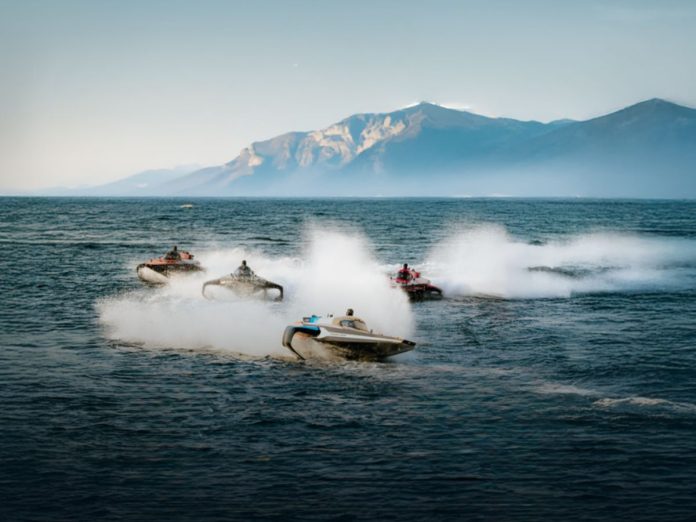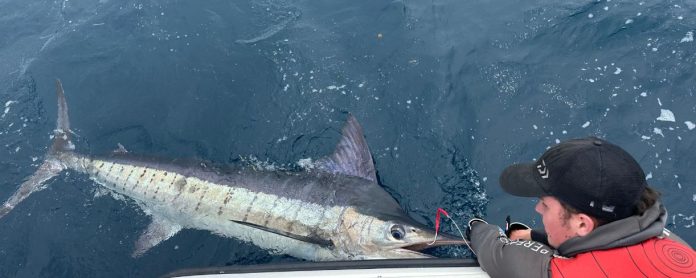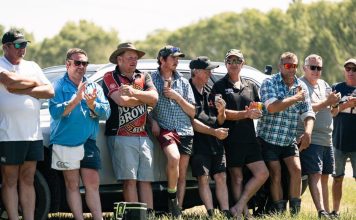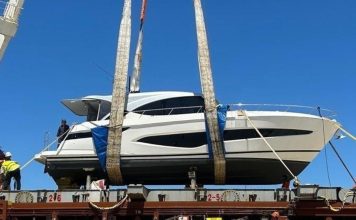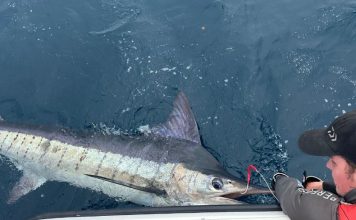Compact yet voluminous, the Lagoon 43 is much more than an entry-level cruiser, reports our Australian correspondent, Kevin Green. Australian and New Zealand dealer The Multihull Group (TMG) imported the first Lagoon 43 (hull number #12) just in time for the 2025 Sanctuary Cove Boat Show, where Kevin had his first look before taking it offshore.
The evolution of modern catamaran design has been remarkable, as computer-aided design and manufacturing allow designers to realise more of a vessel in the same length. Builder Lagoon is known for this, its famous VPLP design house building boats from ‘the inside out’ with liveability and usability at their core. In recent years, carbon emissions have also become a factor, so efficient sailplans to move the vessels in lighter winds and minimise engine usage has become a trend.
French builder Lagoon currently offers several smaller vessels – the 38, the 42 and now the 43, with the mid-range 46 a fairly big upgrade because of its full-sized flybridge. The smaller catamarans all have semi-flybridges, with an elevated single helm alongside a low-profile lounge space below the mainsail boom.
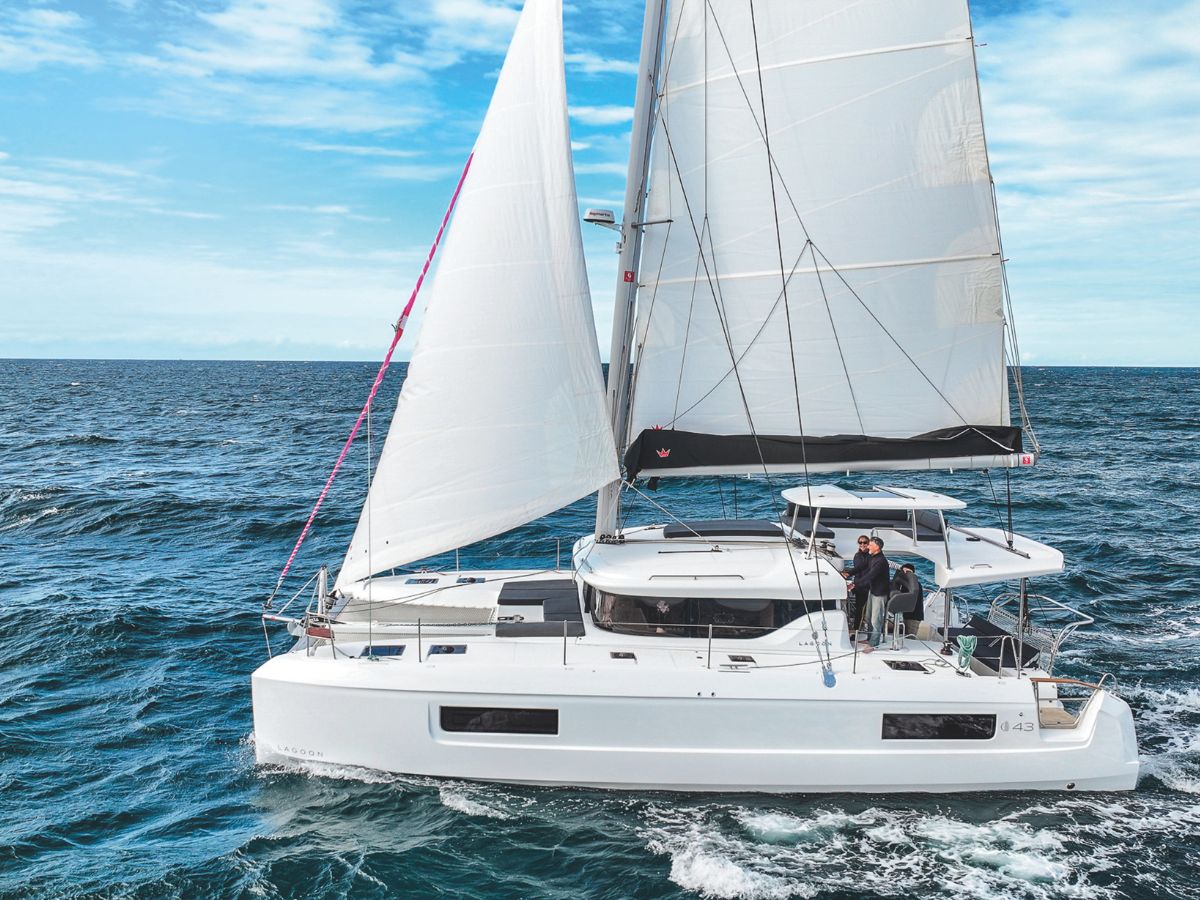
There’s more emphasis on performance with the Lagoon 43, including an upgraded rig with the twin spreader mast located further aft (thus giving a more even coverage of sail across the hull). This also creates a larger jib for better windward abilities.
Over the years, I’ve found several key features of note on these smaller Lagoons. The spacious saloon, protected by a GRP lip, minimises the effects of the Pacific sun, and in terms of the hull, they’re a manageable overall size for those tricky marina manoeuvres. An elevated steering console ensures good vision, and all the sail controls terminate there as well, so the family can safely enjoy the large aft cockpit. Water access is another catamaran plus, and the Lagoon 43 is no exception, with steps on each hull and davits for the dinghy in between. But a major change on the 43 is hull doors on each side – ideal when boarding from marina pontoons.
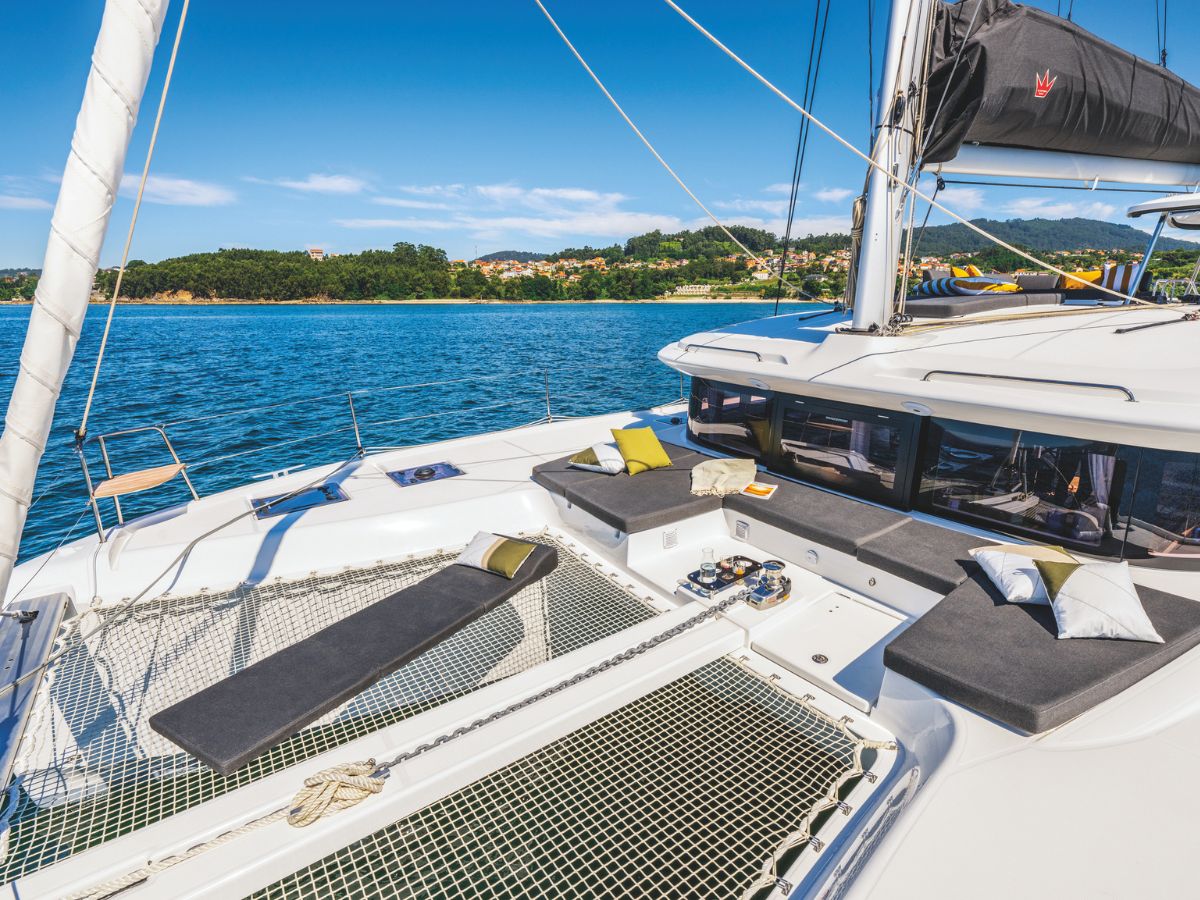


Cockpit and open plan saloon
The most frequented spot on cruising catamarans is the aft cockpit, a place buyers scrutinise carefully, so it should always make a positive first impression. Acres of open space are not desirable at sea, unlike in port, where catamarans are often the social hubs for raft-ups. So, the modest-sized cockpit of the Lagoon 43 is nicely in proportion, and the dining area is sheltered below the fibreglass saloon overhang.
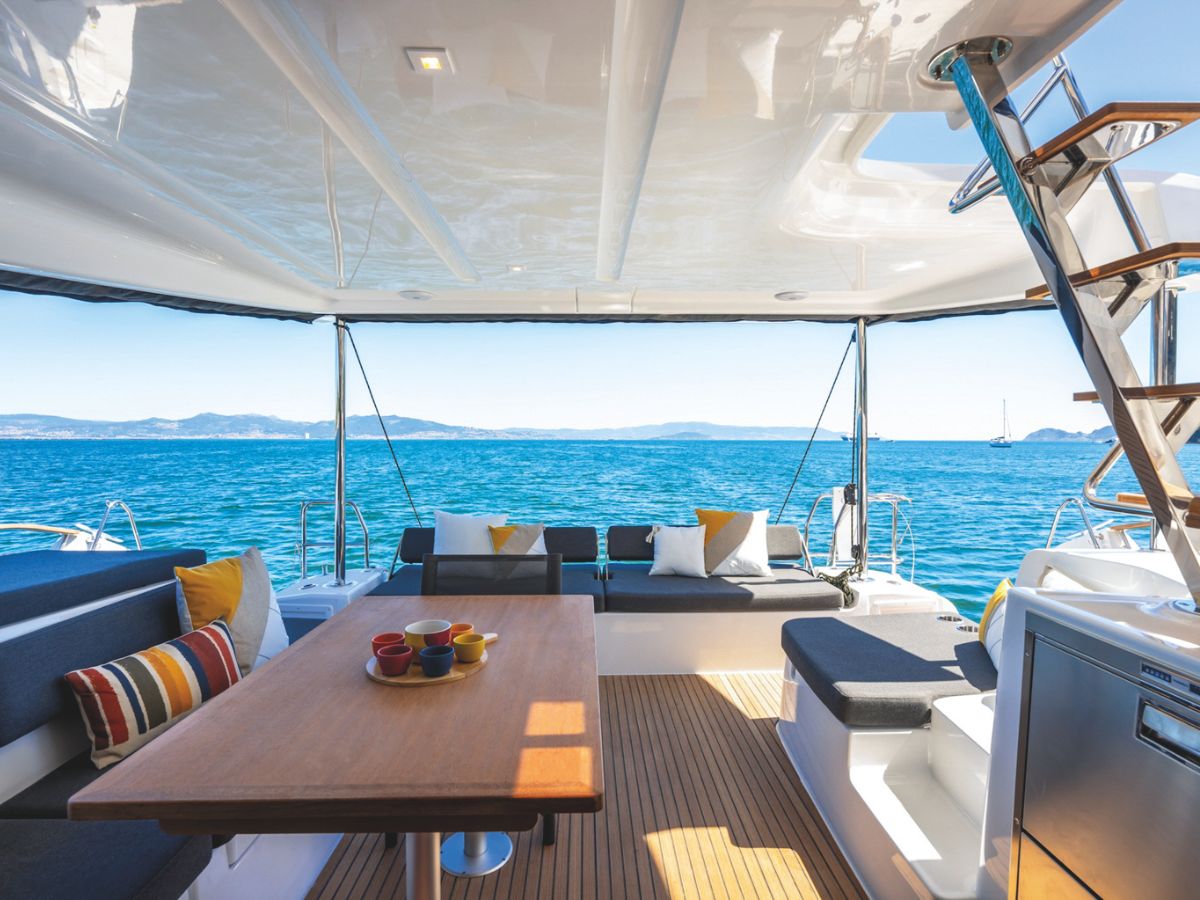
Our review boat came with artificial teak underfoot and the upgraded transom two-way folding bench with a clever netted swim platform and davits. Benches on each side and ample storage were other notable points, with the single elevated helm on port. The hull side doors add flexibility to this space as well.
Moving inside the saloon via sliding doors reveals ample space. In this ‘reimagined’ design, the galley is on the forward port quarter and the dinette on the aft starboard quarter, which allows a clever inside-outside table into the cockpit.

An upright Vitrifrigo fridge-freezer at the back is ideally placed for cockpit dining access as well. Bench seating to starboard for the lounge and surrounding cupboard space gives good storage, with the benchtop on the starboard forequarter serving as a navigation station and the Raymarine plotter and main switchboard nearby.
The entire saloon is well shaded, thanks to those signature upright Lagoon bulkheads, softened externally by a fibreglass lip. These upright bulkheads also add volume. A large opening window forward and two smaller ones each side provide adequate ventilation. The saloon’s downside is windage, so you may tend to dodge around at anchor, but the benefits are plain to see when you consider the excellent headroom throughout.
The longitudinal galley can accommodate several people at once and its amenities include twin stainless sinks. A three-burner stove-oven with microwave slot below does the cooking. Perishables go into an upright fridge and twin-drawer freezers. The Sand Oak woodwork is CNC-perfect, so all the finishing is smooth. Solid metal fixings on doors and gas struts on the cabinetry impressed me – features I feel earlier Lagoons were lacking. Overall, regular collaborator Nauta Design has created a usable saloon with plenty of locker space, soft-close drawers and underfloor storage.
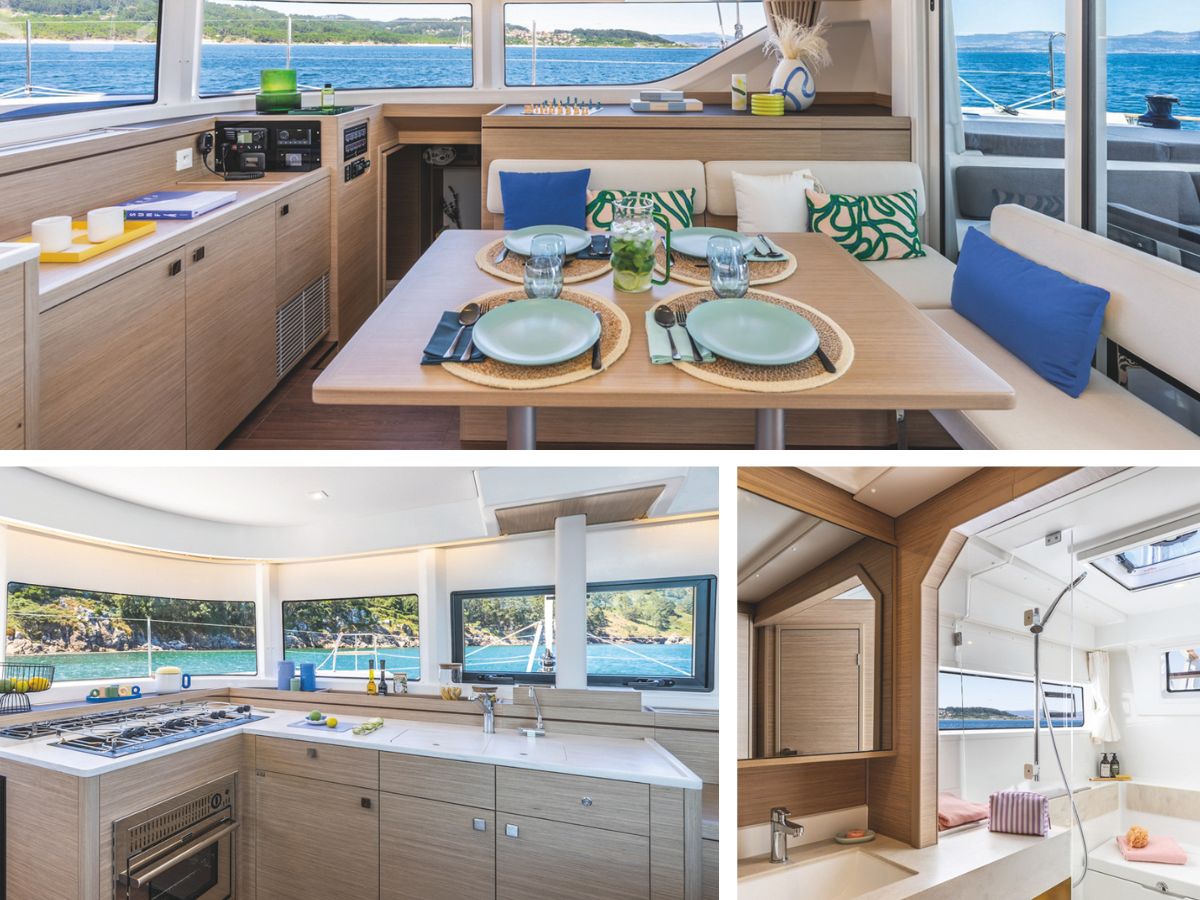
Owner’s layout
Our review boat was the ‘owner’s’ version – a three-cabin layout that uses the entire starboard hull for the owners, with the bed forward and the bathroom aft with generous storage and a desk between them. Guests get the port hull with berths at each end and ensuites between – ideal for privacy. Cabin access is downstairs to each side of the nacelle, the stairs easily removable for quick access to the escape hatches – essential on seaworthy sailing catamarans.
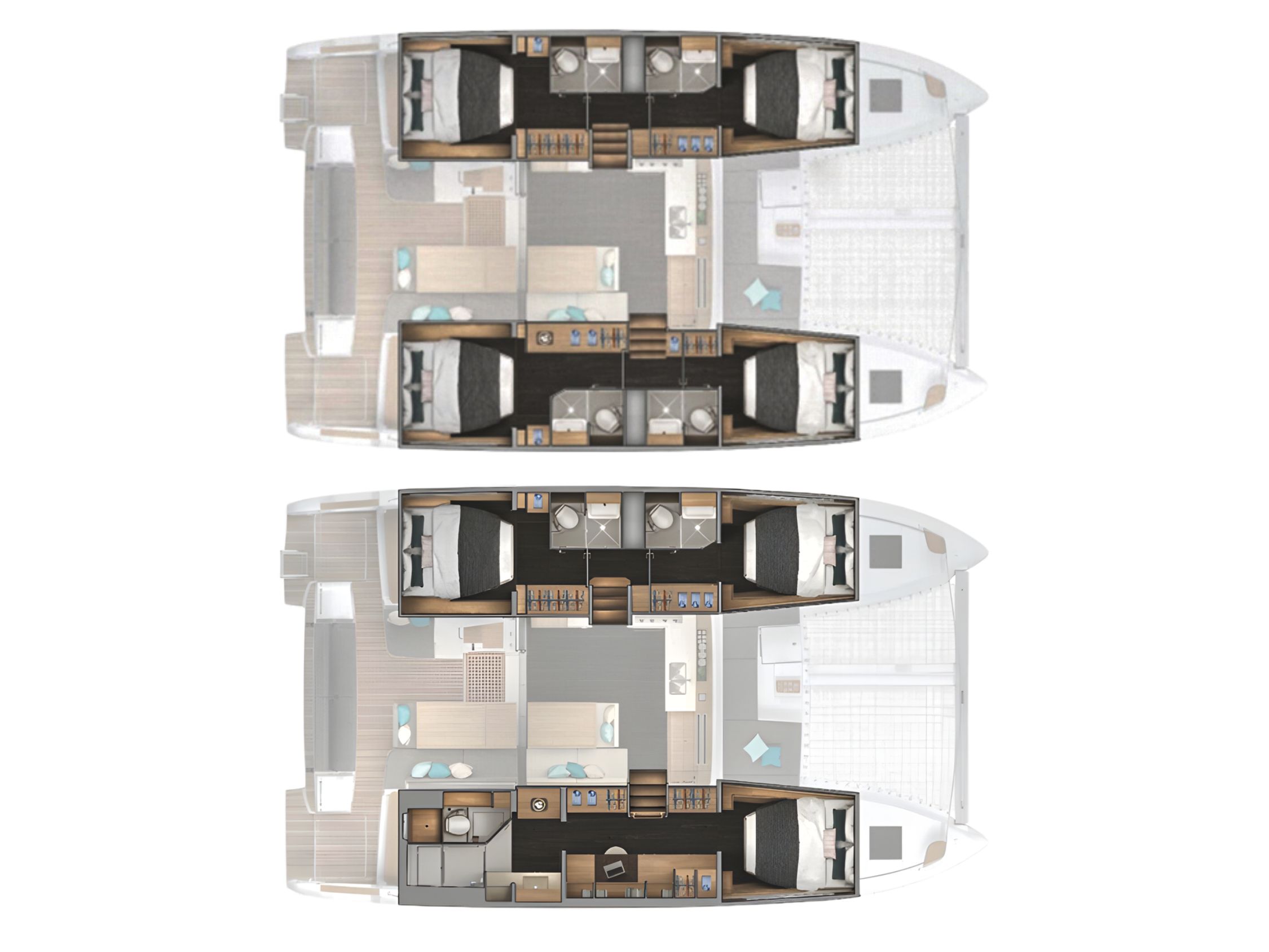
In the four-cabin layout, both aft cabins are the same, as are the two in the bows. Greater volume aft makes the aft cabins the largest, with the double bed given a slot to allow access alongside it.
Looking around the owner’s suite, I was again amazed by how much volume there is for a 45-footer. This stems from voluminous hulls with tall topsides, but also clever design. The interior certainly avoids feeling claustrophobic, unlike on some similarly sized monohulls. The queen-sized bed in the bow is well away from engine noise, but lying in this forward berth can be bumpy in a seaway, but aside from that, it has plenty of merit, including ample storage in tall cupboards.
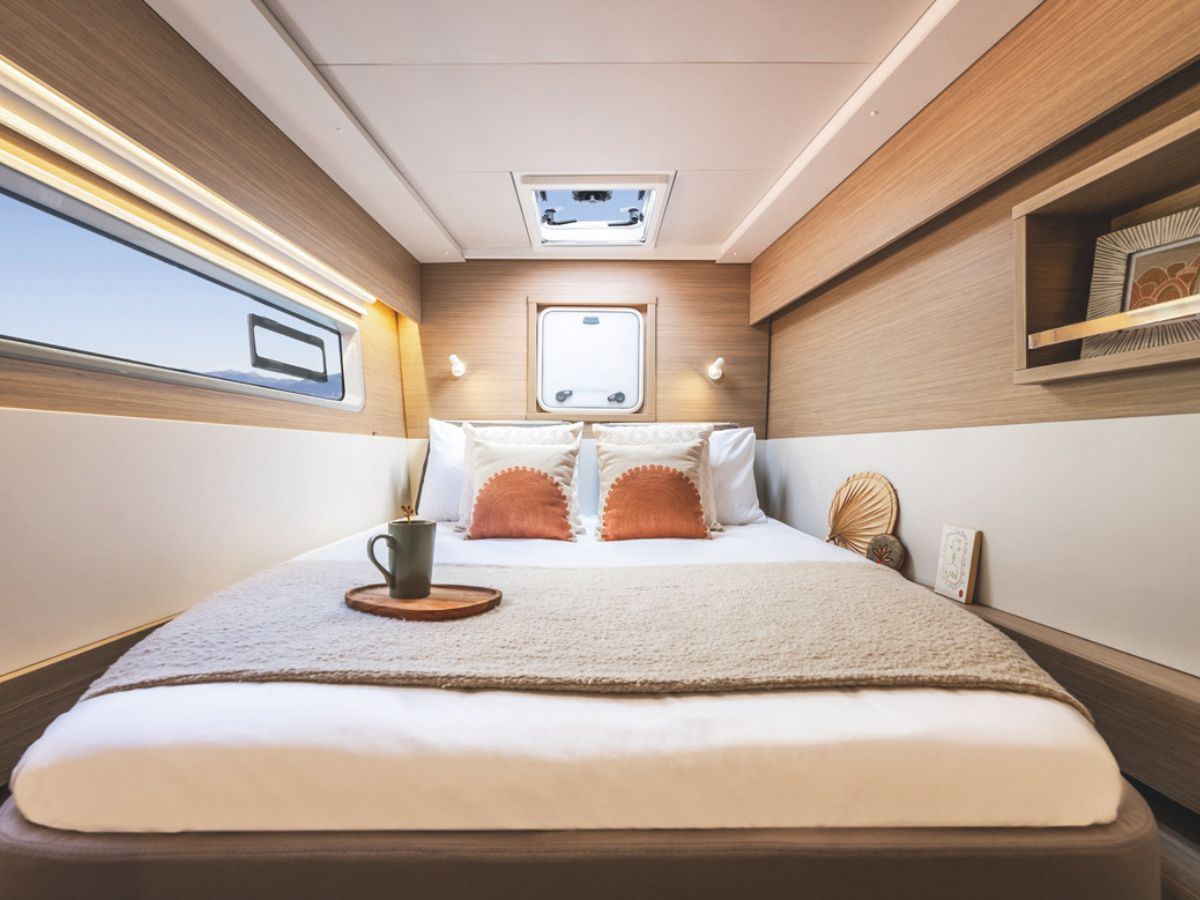
This cabin is full of natural light, there’s good ventilation from skylights, portlights, and an aft opening port in the bathroom. Other good features include slatted bed bases with memory-style foam mattresses, but beware the protruding cupboard handles on your way to bed!
The forward berth uses an island bed for easy access. Again, ventilation is good, while the man-size escape hatch onto the foredeck could also aid airflow. Cabin locker space includes an under-bed drawer; while the long rectangular portlight gives occupants panoramic views.
The aft bathroom benefits from being in the most voluminous part of its hull, with a spacious separate shower cubicle and a large sink-vanity. Again, there’s ample ventilation – the only negative is the sharp edges on some bulkheads. Access to plumbing and seacocks is generally good throughout, which reflects the fact that Lagoon has been building interiors since their first hull in 1987, so there are generally few surprises.
In the guest hull, my pick would be the aft cabin, which benefits from hatches aft and a kinder motion at sea. Both guest cabins have large island beds, tall wardrobes and shelves. Their bathrooms have electric freshwater heads and share the sink space with the shower, but are more than adequate for most users and easily wiped down.
Simple sail plan
You helm the Lagoon 43 from a high, commanding position, which imbues confidence. Console controls include a large-diameter stainless steering wheel, ideal whether standing or sitting to steer, while electronics include a Raymarine plotter with depth sounder and the essential autopilot, twin throttles and Yanmar engine gauges below. The hard bimini has a handy movable hatch through which to see the mainsail – good ergonomics.
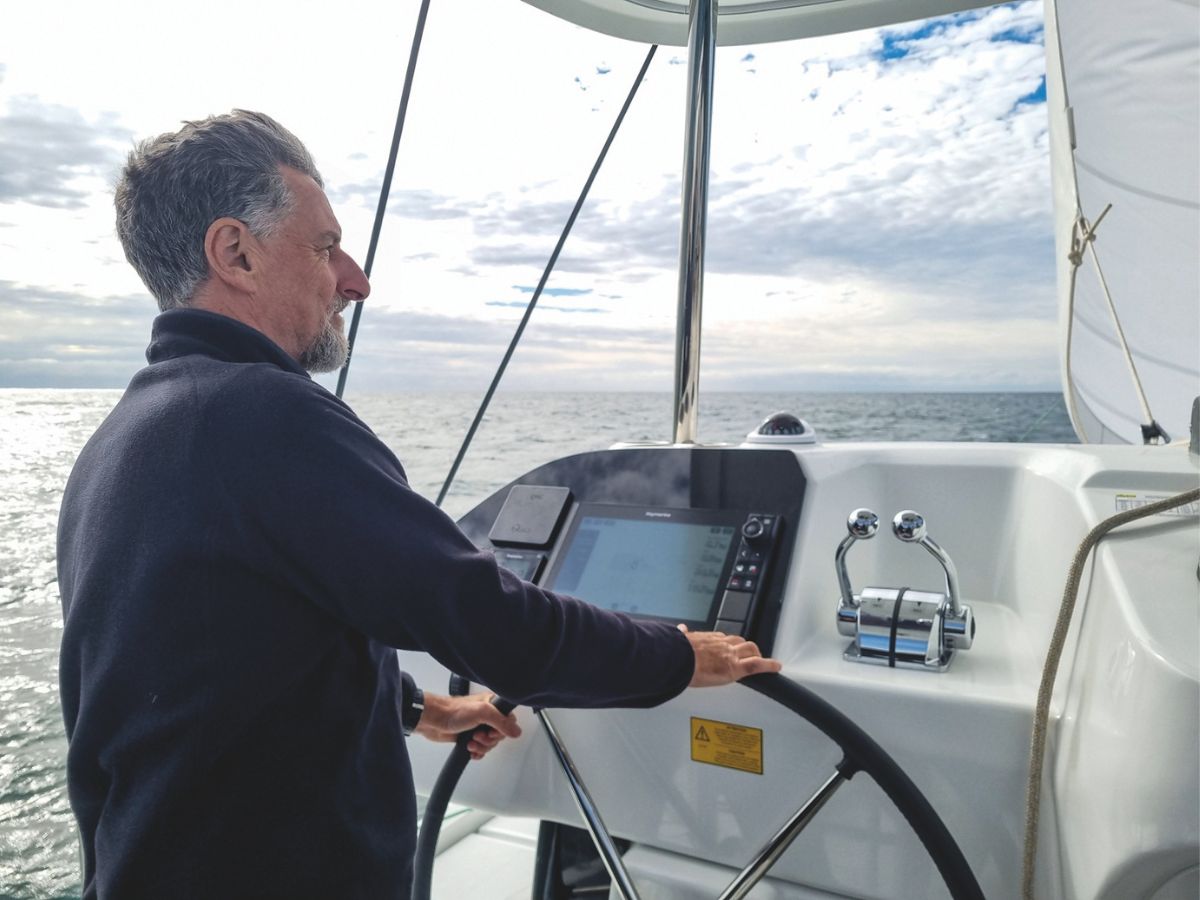
A raised steering console dictates a fairly high main boom but it’s easily accessible by stepping up from the steering console to the coachroof to tidy the slab-reefed square-top mainsail into the lazyjacks. The wide mainsail track is effectively controlled by jammers and a Harken electric winch, making the sail plan suitable for short-handed sailing.

The mainsheet runs to the same Harken winch as well, with another one on the starboard side of the console for the halyards. Halyards benefit from a short run from the cabin-stepped mast to the banks of jammers within arm’s reach of the wheel, and all lines fall neatly into a large rope bag.
The vessel’s large-diameter lines and oversized winches and jammers will be welcome, especially in heavy weather.

The cabin-stepped rig creates a larger fore-triangle, allowing bigger headsails and our review boat came with a cutter rig – an Elvstrom-branded jib and large screecher on the bowsprit, the latter controlled by deck-level winches on each side. The alloy rig is a sturdy arrangement with chunky outboard chain plates swept back from the mast (catamarans don’t use backstays) on heavy wire shrouds to the gunwales, leaving the decks clear.
Flat decks aid movement around the Lagoon 43, as do flush hatches and handrails on the coachroof.
The foredeck has cockpit benches around the windlass and anchor locker. Safe anchoring is a key part of cruising, so the large Quick windlass with capstan is welcome, and that second bow roller is also handy but could be sturdier. The foredeck is mostly netted, which is best for weight-saving and reducing wave impacts on the nacelle.
Hull and systems
The Lagoon 43 hull shape is substantially different from its predecessors in that its volume is more forward (which allowed the large owner’s bed to be installed there, for instance). While possibly increasing drag, extra volume also enhances buoyancy forward, which is generally good.
Construction is infused polyester with balsa core – a weight-saving change from solid GRP on previous models. At 13.3 tonnes, it’s still a fairly heavy boat compared to, say, its Lagoon 42 sister (43-feet and 12.1 tonnes).
Our review boat came with upgraded twin 47hp saildrive Yanmars accessed via the aft deck hatches. Given the wide hulls, there is ample space for servicing the gearbox oil, filters and impeller.
Other notable systems on the Lagoon 43 include the Seanapps black box and software system, that relays information such as engine data, batteries and even security aspects (dependent on sensors installed), which in turn can inform dealers about reported issues.
Operated from a laptop or a phone app, it gives instant information to the owner. The optional folding propellers were welcome on our review boat, considering the drag from mini keels and sail drive gearboxes.
Gold Coast sail
The Gold Coast’s sheltered waterways, including the Broadwater, are ideal catamaran cruising grounds, so it’s a good place to experience the shallow-drafted Lagoon 43. Departing the busy Gold Coast waterway with TMG dealer representative Joe Fox, we headed offshore.
It is usually an interesting voyage because the Seaway’s ocean entrance often gives vessels a stern initial test. But aboard the Lagoon 43 all went well as I steered us steadily over the swells, the Yanmars pushing us along at 6.5 knots while spinning at 2000rpm.
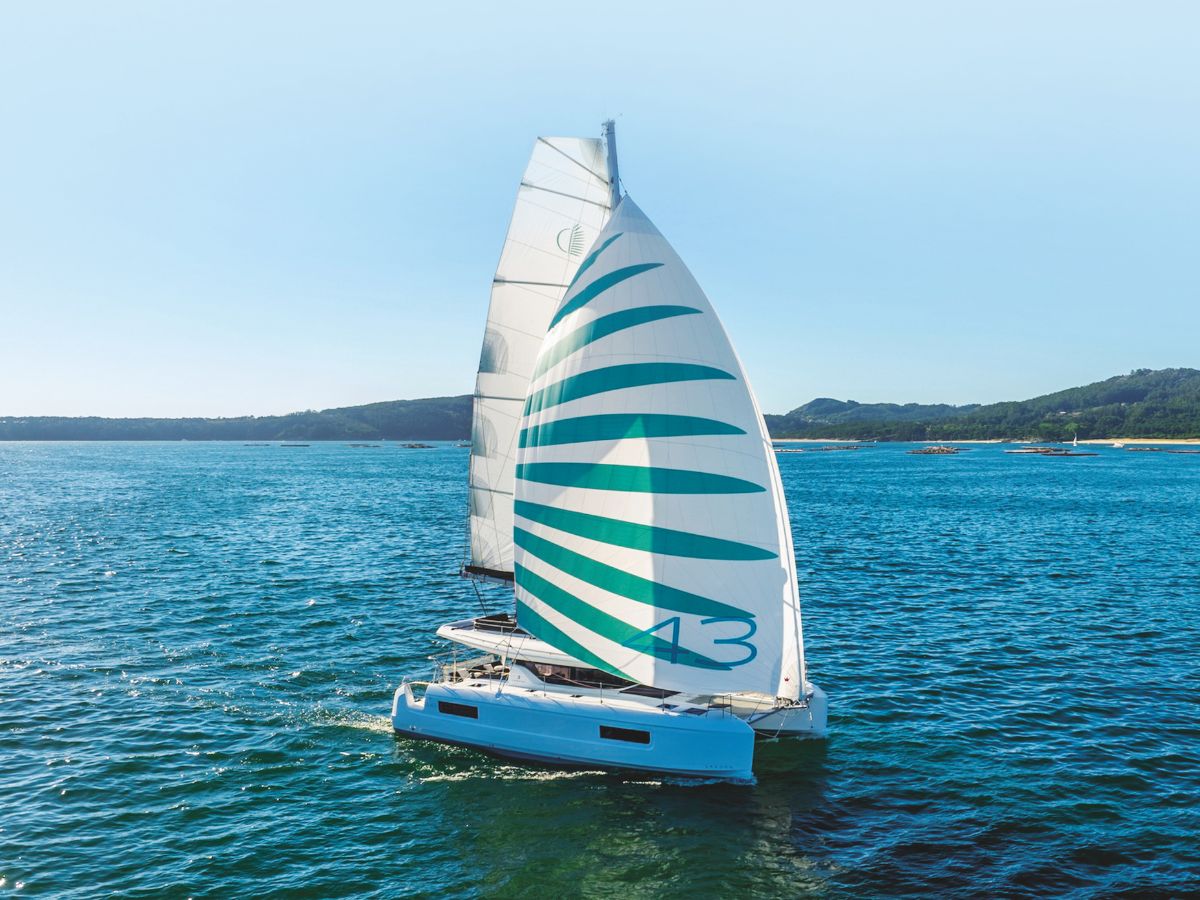
Despite no outboard lifelines, the large bucket seat and helm layout gave me good support and clear views to the bows as I watched for surfers paddling across to South Stradbroke Island. Once clear, the electric Harken 46 and lazyjacks easily hoisted the mainsail before the jib was unfurled and trimmed via its tracks on the coach roof.
Pointing at 70 degrees in the 16-knot breeze, the speed showed an impressive 8.1 knots. It’s an ideal angle for this kind of cruising catamaran with only mini keels.
The large steering wheel and mechanical linkages gave sufficient feedback to tell me how the loading was going on the twin rudders, making for an enjoyable experience.
Tacking was also drama-free despite bashing into one-metre swells. All sheets were near me on the helm, so it could have been a one-person job.
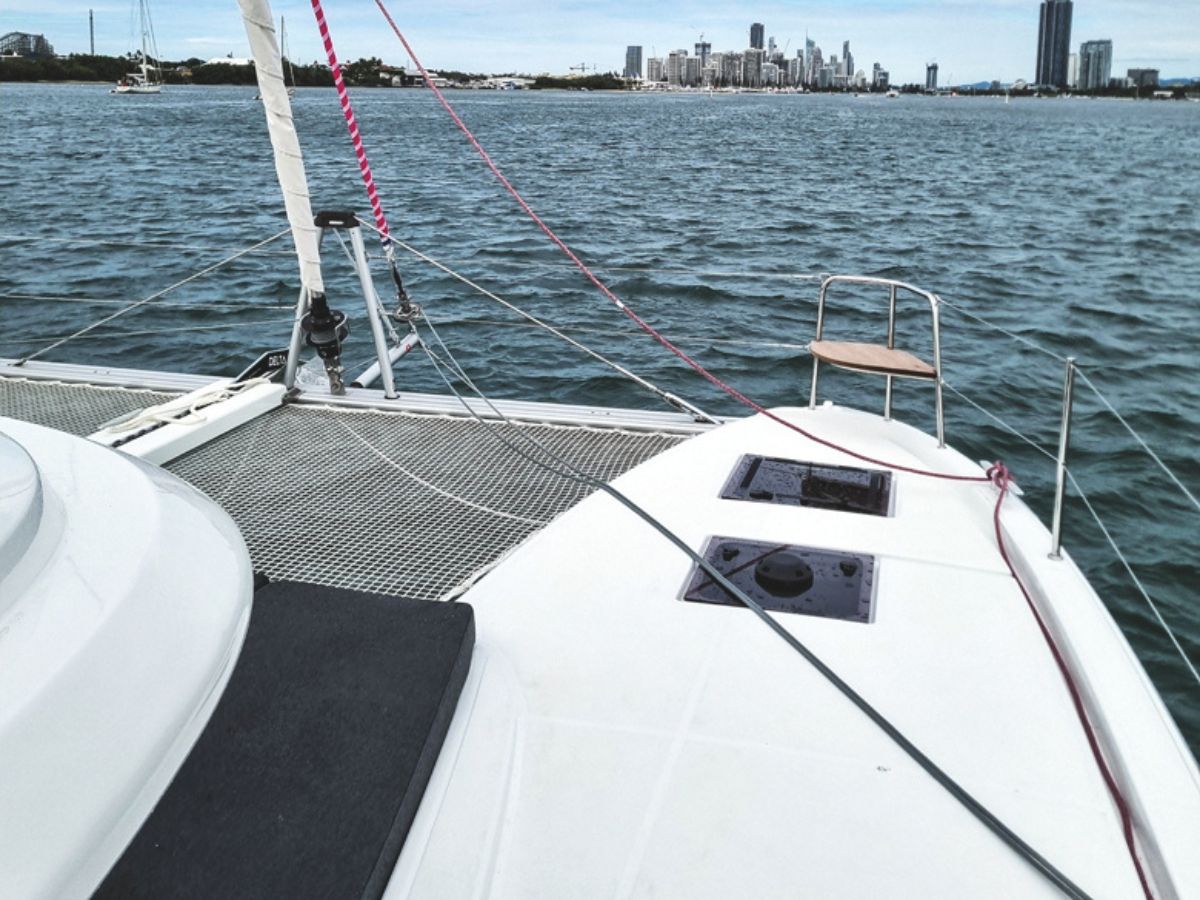
Easing to a beam reach as we sailed past the skyscrapers of the Surfers Paradise, the wind had increased to 19 knots and our speed to 8.5 knots – nothing spectacular, but a pleasant, steady motion, which sums up this Lagoon 43. Typical of the brand, it does everything it’s built to do and does it in a very comfortable way.
BNZ
Lagoon 43 Highlights
Design
Architects VPLP DESIGN / Patrick le Quemont
Interior design Nauta Design
Manufactured by Lagoon Catamarans
Specifications
LOA 13.85 m
Beam 7.69 m
Mast height 19.94m
Draft 1.40 m
Displacement (ECC) 13,319kg
Upwind sail area 97 m²
Full batten mainsail 60 m² (68 m² square top option)
Jib 37 m²
Water 2 x 300l
Fuel 2 x 570l
Engine 2 x 57hp Yanmar sail drives
Berths 6 to 13
EC Certification A: 12, B: 14, C: 20, D: 30
Highlights
Spacious, comfortable cruiser that sails well
Easy sail plan, easy sail handling
Great indoor-outdoor flow, brilliant outdoor dining
Lots of volume for a 45-footer
Price
Packages from AUD$1,435,000
Price as reviewed AUD$1,752,569
Learn more
www.catamarans-lagoon.com
www.themultihullgroup.com
www.36degrees.nz









